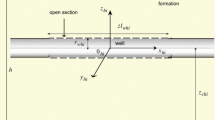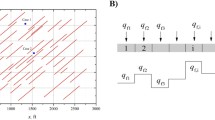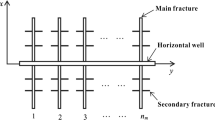Abstract
Hydraulic fracturing may induce horizontal fractures in shallow, tectonically active or high-reservoir-pressure formations. Studying the pressure transient behavior of the horizontal fractures can provide insights into the size and shape of the formations as well as their productivities. However, our knowledge about the pressure transient behavior of a horizontal fracture is far from adequate. In this study, a semi-analytical model is proposed to characterize the pressure transient behavior of finite-conductivity horizontal fractures in bounded reservoirs. Specifically, we discretize the horizontal fracture into rectangle plane elements, each of which is treated as a plane source. (In this work, a plane source indicates a rectangle plane, and the oil flows from the matrix to this plane.) The transient flow in the fracture systems can be numerically characterized with the finite difference method, whereas the transient flow in the matrix system can be analytically simulated with the Green function method; as such, the flow behavior in both the fracture and matrix can be modeled. Subsequently, we construct the mathematical model by coupling the finite difference formulations for the fracture system and the analytical functions for the matrix system. This semi-analytical model is arranged into a matrix format and can be readily solved with the Gaussian elimination method. The key features of the proposed approach can be summarized as: it can model an irregular horizontal fracture by discretizing the horizontal fracture into small elements, such that the real fracture configuration can be better captured; the fracture conductivity can be taken into consideration; and the non-uniform influx distribution along the fracture can be modeled to better honor the actual flow behavior from the matrix to the fracture. We also apply the semi-analytical method to analyze the flow regimes of single-phase oil flow from a circular horizontal fracture and an elliptical horizontal fracture in a bounded reservoir; the flow regimes such as wellbore after flow, bilinear flow, formation linear flow, early pseudo-radial flow, late pseudo-radial flow, elliptical flow, and boundary dominated flow can be observed during oil production. In addition, we examine the influences of formation thickness, fracture’s vertical position, fracture conductivity, and wellbore storage on the pressure dynamics of a circular horizontal fracture. It is found that the early pseudo-radial flow results from two different flow scenarios: one is near the edge of the horizontal fracture when the formation thickness is small, while the other one is surrounding the horizontal fracture in the vertical direction when the formation thickness is sufficiently large. The wellbore storage mainly exerts influences on the early production period, and its duration tends to be longer as the fracture conductivity decreases. Furthermore, the flow regimes and pseudo-skin factor are comprehensively investigated for an elliptical horizontal fracture and an irregular-shaped horizontal fracture that may be induced by the stress heterogeneity in the reservoirs.





















Similar content being viewed by others
Abbreviations
- a :
-
Semimajor axis, m
- b :
-
Semiminor axis, m
- a D :
-
Dimensionless semimajor axis
- b D :
-
Dimensionless semiminor axis
- B :
-
Formation volume factor
- c f :
-
Fracture compressibility, MPa
- c l :
-
Liquid compressibility, MPa
- c tf :
-
Total compressibility of fracture, MPa
- c tm :
-
Total compressibility of matrix, MPa
- C :
-
Wellbore storage coefficient, m3/MPa
- C s :
-
A dimension coefficient defined in this work
- h :
-
Reservoir thickness, m
- k f :
-
The fracture permeability, mD
- k m :
-
Matrix permeability, mD
- l r :
-
Reference length, m
- N f :
-
Number of the fracture elements
- p :
-
Pressure, MPa
- p f :
-
Pressure in the fracture system, MPa
- p 0 :
-
Reference pressure, MPa
- p w,cir :
-
Dimensionless bottomhole pressure of the circular horizontal fracture
- p w,non :
-
Dimensionless bottomhole pressure of the non-circular horizontal fracture
- q f-wD :
-
Dimensionless flux from well-element to wellbore
- q sc :
-
Withdraw rate, m3/day
- q w :
-
Production rate under standard condition, m3/day
- r w :
-
Radius of the wellbore, m
- r eq :
-
Equivalent radius, m
- s :
-
Laplace operator
- S :
-
Pseudo-skin factor
- t 0 :
-
Time when the source term becomes activated, day
- t :
-
Time, day
- u x , u y , and u z :
-
Darcy flow rate, m/day
- V b :
-
Bulk volume, m3
- w :
-
Fracture width, m
- x :
-
x-coordinate, m
- y :
-
y-coordinate, m
- z :
-
z-coordinate, m
- z vD :
-
Fracture vertical position
- α :
-
Diffusivity, m2/day
- β :
-
Unit conversion factor whose numerical value is 0.0853, (m2 s)/(mD d)
- γ :
-
A dimensionless coefficient
- δ :
-
Influx of various dimensions, 1, m, m2, or m3
- μ :
-
Viscosity, mPa s
- ρ :
-
Fluid density, kg/m3
- ρ sc :
-
Fluid density under standard condition, kg/m3
- ϕ 0 :
-
Reference porosity
- ϕ f :
-
Porosity in the fracture
- ϕ m :
-
Matrix porosity
- f :
-
Fracture
- i :
-
Initial condition
- m :
-
Matrix
- sc:
-
Standard condition
- t :
-
Total
- w :
-
Wellbore
References
AccuMap: Information Handling Services Markit, London, UK (2013)
Brown, M.L., Ozkan, E., Raghavan, R.S., Kazemi, H.: Practical solutions for pressure transient responses of fractured horizontal wells in unconventional reservoirs. SPE Res. Eval. Eng. 14(05), 663–676 (2009)
Chen, C., Raghavan, R.: A multiply-fractured horizontal well in a rectangular drainage region. SPE J. 2(04), 455–465 (1997)
Chen, H.Y.: Well Behavior in Naturally Fractured Reservoirs. Ph.D. Dissertation, Texas A&M University, College Station (1990)
Chen, H.Y., Poston, S.W., Raghavan, R.: An application of the product solution principle for instantaneous source and green’s functions. SPE Form. Eval. 6(02), 161–167 (1991)
Chen, Z., Liao, X., Zhao, X., Lv, S., Zhu, L.: A semianalytical approach for obtaining type curves of multiple-fractured horizontal wells with secondary-fracture networks. SPE J. 21(02), 538–549 (2016)
Chhina, H.S., Luhning, R.W., Bilak, R.A., Best, D.A.: A horizontal fracture test in the Athabasca oil sands. Paper PETSOC-87-38-56 Presented at Annual Technical Meeting, Calgary, Alberta, 7–10 June (1987)
Cinco-Ley, H., Samaniego, V.F.: Transient pressure analysis for fractured wells. J. Pet. Technol. 33(09), 1749–1766 (1981)
Cinco-Ley, H., Samaniego, V.F., Dominguez, A.N.: Transient pressure behavior for a well with a finite-conductivity vertical fracture. SPE J. 18(04), 253–264 (1978)
Crawford, P.B., Landrum, B.L.: Estimated effect of horizontal fractures on production capacity. Paper Presented at Fall Meeting of the Petroleum Branch of AIME, San Antonio, Texas, 17–20 October (1954)
Crawford, P.B., Pinson, J., Simmons, J., Landrum, B.L.: Effect of elliptical fractures on sweep efficiencies in water flooding or fluid injection programs. SPE-602-MS (1963)
Ertekin, T., Abou-Kassem, J.H., King, G.R.: Basic Applied Reservoir Simulation. SPE Textbook Series, New York (2001)
Escobar, F.H., Montealegre, M.: Conventional analysis for the determination of the horizontal permeability from the elliptical flow of horizontal wells. Paper SPE 105928 Presented at Production and Operations Symposium, Oklahoma City, Oklahoma, USA, 31 March–3 April (2007)
Gringarten, A.C., Ramey, H.J.: The use of source and green’s functions in solving unsteady-flow problems in reservoirs. SPE J. 13(05), 285–296 (1973)
Gringarten, A.C., Ramey, H.J.: Unsteady-state pressure distributions created by a well with a single infinite-conductivity vertical fracture. SPE J. 14(04), 347–360 (1974a)
Gringarten, A.C., Ramey, H.J.: Unsteady-state pressure distributions created by a well with a single horizontal fracture, partial penetration, or restricted entry. SPE J. 14(04), 413–426 (1974b)
Hubbert, M.K., Willis, D.G.: Mechanics of hydraulic fracturing. SPE Trans. AIME 210, 153–168 (1957)
Kucuk, F., Brigham, W.E.: Transient flow in elliptical systems. SPE J. 19(06), 401–410 (1979)
Larsen, L.: Horizontal fractures in single and multilayer reservoirs. Paper Presented at Canadian Unconventional Resources Conference, Calgary, Alberta, 15–17 November (2011)
Nicholl, M.J., Glass, R.J.: Simulation of immiscible viscous displacement within the plane of a horizontal fracture. Paper ARMA-01-0205 presented at the 38th US Symposium on Rock Mechanics (USRMS), Washington, DC, 7–10 July (2001)
Ogunsanya, B.O., Oetama, T.P., Lea, J.F., Heinze, L.R., Adisoemarta, P.S.: A robust type curve solution for analyzing pressure-transient behaviors of both vertical and horizontal fracture systems. Paper Presented at Nigeria Annual International Conference and Exhibition, Abuja, Nigeria, 31 July–2 August (2006)
Ozkan, E., Raghavan, R.: New solutions for well-test-analysis problems: Part 1—analytical considerations. SPE Form. Eval. 6(03), 359–368 (1991)
Ozkan, E., Brown, M.L., Raghavan, R., Kazemi, H.: Comparison of fractured-horizontal-well performance in tight sand and shale reservoirs. SPE Res. Eval. Eng. 14(02), 248–259 (2011)
Peaceman, D.W.: Interpretation of wellblock pressures in numerical reservoir simulation: Part 3—off-center and multiple wells within a wellblock. SPE Res. Eng. 5(02), 227–232 (1990)
Reynolds, A.C., Chen, J.C., Raghavan, R.: Pseudoskin factor caused by partial penetration. J. Pet. Technol. 36(12), 2197–2210 (1984)
Singh, K., Whitson, C.H.: Gas-condensate pseudopressure in layered reservoirs. SPE Res. Eval. Eng. 13(02), 203–213 (2010)
Smith, M.B., Montgomery, C.: Hydraulic Fracturing. CRC Press, Boca Raton (2015)
Spivey, J.P., Lee, J.: New solutions for pressure transient response for a horizontal or a hydraulically fractured well at an arbitrary orientation in an anisotropic reservoir. Paper SPE 49236 Presented at SPE Annual Technical Conference and Exhibition, New Orleans, Louisiana, 27–30 September (1998)
Valko, P., Economides, M.J.: Transient behavior of finite conductivity horizontal fractures. SPE J. 2(02), 213–222 (1997)
Valko, P.P., Amini, S.: The method of distributed volumetric sources for calculating the transient and pseudosteady-state productivity of complex well-fracture configurations. Paper Presented at SPE Hydraulic Fracturing Technology Conference, College Station, Texas, 29–31 January (2007)
van Everdingen, A.F., Hurst, W.: The application of the laplace transformation to flow problems in reservoirs. AIME Pet. Trans. 1(12), 305–324 (1949)
Wahl, H.A.: Horizontal fracture design based on propped fracture area. SPE J. 17(6), 723–730 (1965)
Wahl, H.A., Campbell, J.M.: Sand movement in horizontal fractures. SPE J. 15(11), 1239–1246 (1963)
Warren, J.E., Root, P.J.: The behavior of naturally fractured reservoirs. SPE J. 3(03), 245–255 (1963)
Wright, E.A., Davis, E.J., Weijers, L., Minner, W.A., Hennigan, C.M., Golich, G.M.: Horizontal hydraulic fractures: oddball occurrences or practical engineering concern? Paper Presented at SPE Western Regional Meeting, Long Beach, California, 25–27 June (1997)
Yang, D., Zhang, F., Styles, J.A., Gao, J.: Performance evaluation of a horizontal well with multiple fractures by use of a slab-source function. SPE J. 20(03), 652–662 (2015)
Yu, W., Wu, K.: A semianalytical model for production simulation from nonplanar hydraulic-fracture geometry in tight oil reservoirs. SPE J. 21(3), 1028–1040 (2016)
Zhou, W., Banerjee, R., Poe, B.D., Spath, J.: Semianalytical production simulation of complex hydraulic-fracture-networks. SPE J. 19(01), 6–18 (2014)
Acknowledgements
The authors would like to acknowledge the financial supports provided by the Natural Science and Engineering Research Council of Canada (NSERC) as well as the financial supports from China Scholarship Council (CSC). The authors also thank Schlumberger for providing us the academic license of Eclipse.
Author information
Authors and Affiliations
Corresponding author
Appendices
Appendix A: Numerical Solution for the Oil Flow in the Horizontal Fracture
The 2D continuity equation is given as (Ertekin et al. 2001):
where ρ is fluid density, u x , u y , and u z are Darcy flow rate, Vb is bulk volume, and for a single fracture element Vb = w∆x i,j ∆y i,j . Equation (A-1) is a partial differential equation, and we can solve it with finite difference method. Implicit finite difference method is utilized in this work because the results of implicit finite difference method are more stable than the explicit finite difference method. The finite difference approximation in this work is based on 5-point scheme, which has a truncation error proportional to (∆x)2 (or (∆y)2) and ∆t. The implicit finite difference approximation based on the 5-point scheme can provide sufficiently accurate results for simulating the transient fracture flow. Multiplying Eq. (A-1) by the bulk volume gives:
Based on Darcy equation, we have,
and the formation volume factor is defined as:
For a slightly compressible fluid, we have
where cl is fluid compressibility and p0 and ρ0 are reference pressure and reference density, respectively. For the porous media, we have
The fracture total compressibility is given as:
where ϕ0 is reference porosity, and cf is compressibility of the matrix or fracture. Inserting Eqs. (A-3) to (A-7) into Eq. (A-2) yields:
Applying the finite difference approximation to the first term on the left-hand side of Eq. (A-8), we can have:
where
and
Thus, Eq. (A-9) can be written as:
Similarly, the second term on the left-hand side of Eq. (A-8) can be rewritten as:
Applying backward-difference approximation on the time derivative, we can obtain:
The backward-difference approximation of the flow equation can be written as:
Equation (A-15) can be used to characterize the transient flow in the fracture system. This equation is also applicable if the fracture has non-uniform fracture width and fracture conductivity distribution. In this work, we assume that the fracture width and fracture conductivity are both uniform along the fracture; thus, Eq. (A-15) can be simplified as:
In particular, for the well-element, the approximated flow equation can be written as:
Non-dimensionalizing the variables in Eqs. (A-16) and (A-17) based on Table 1 yields,
and
Rearranging Eqs. (A-18) and (A-19) gives the following:
As such, in Eqs. (A-20) and (A-21), the dimensionless pressures, dimensionless withdrawal rates, and dimensionless flux from fracture to wellbore on the LHS become the unknowns. The flow equations for the Nf facture elements can be then written in a matrix form,
where
where A is a matrix with a dimension of Nf × 2Nf and it represents the coefficients of the dimensionless pressures and the coefficients of dimensionless withdrawal rates of the fracture elements in Eqs. (A-20) and (A-21), and nw is the number of the well-element.
Appendix B: Analytical Solution for the Oil Flow in the Reservoir Matrix
Figure 22 shows a line source in a bounded reservoir and a plane source in a bounded reservoir, respectively. In a 2D reservoir, the pressure response at position x at time t caused by an instantaneous line source which is activated at time t0 is given by Gringarten and Ramey (1973):
where δ is the withdrawal rate per unit length, unit area or unit volume. Equation (B-1) is derived using the Green function method. Similarly, the following equation can be used to predict the pressure response at position x at time t caused by an instantaneous plane source which is activated at time t0,
where ∆x is the width of the plane source.
Figure 23 shows a plane source in a 3D bounded reservoir. According to the Newman product principle, the pressure response of an instantaneous plane source in a 3D reservoir can be obtained by the product of a plane source in X direction and a plane source in Y direction and a line source in Z direction:
The pressure response at point (x, y, z) at time t due to the contribution by a continuous plane source with a withdrawal rate of qsc can be calculated by:
where
Thus, Eq. (B-4) can be written as:
In the production period, the withdrawal rate of a plane source is time dependent. The pressure response at position (x, y, z) at time tn caused by a time-dependent continuous plane source is
Since we discretize the horizontal fracture into Nf fracture elements, the pressure response at a given position (x, y, z) should be the summation of the pressure responses caused by all of the elements, leading to the following:
Equation (B-8) can be written in a dimensionless form,
Based on Eq. (B-9), we can have,
Combining Eq. (B-9) with Eq. (B-10), we can have:
As for a given fracture element, we use the dimensionless pressure at the center of this fracture element to represent the average pressure within this fracture element. Based on Eq. (B-11), the dimensionless pressure at the center of the fracture element can be obtained by:
where (x0D,g, y0D,g, z0D,g) indicates the position of the center of the gth fracture element (g = 1, 2,… Nf) and pfD,g indicates the dimensionless average pressure of the gth fracture element. For convenience, Eq. (B-12) can be also written as:
where
Moving the unknowns in Eq. (B-13) to the left-hand side, we can have:
As a result, we can formulate the dimensionless pressures of the fractures elements and dimensionless withdrawal rates of the fracture elements into a matrix form:
where
Rights and permissions
About this article
Cite this article
Teng, B., Li, H.A. A Semi-Analytical Model for Characterizing the Pressure Transient Behavior of Finite-Conductivity Horizontal Fractures. Transp Porous Med 123, 367–402 (2018). https://doi.org/10.1007/s11242-018-1047-9
Received:
Accepted:
Published:
Issue Date:
DOI: https://doi.org/10.1007/s11242-018-1047-9






